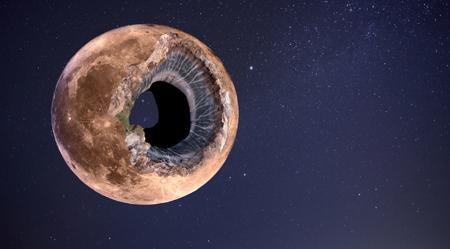Coincidence or an Alien Hand at Work?
In one of the most striking of cosmic coincidences, the Moon is about 400 times smaller than the Sun, and is also about 400 times closer to the Earth. This fact makes both these heavenly bodies appear to be of the same size, and also results in the phenomenon of total solar eclipses taking place.
The Apollo moon landing missions were surely a giant leap for mankind. However, apart from being the first set of missions to take men to the Moon, there was something else about one particular mission―Apollo 12, launched in November 1969―which was equally significant, not to mention absolutely bizarre! It was what took place when NASA decided to crash one of the spent lunar modules on the Moon’s surface.
Scientists wanted to find out what the geological make-up of the Moon was like. So they devised an experiment which involved the use of seismic sensors to measure lunar vibrations. Once these sensors were in place on the Moon’s surface, scientists had a spent rocket lift-off stage crash onto it. The module impacted the lunar surface with a force equivalent to a one-ton TNT bomb, and created its own crater. What the seismic sensors subsequently recorded, however, sent the whole of NASA ringing!
When the collision happened, the Moon literally rang like a bell for more than half an hour. This phenomenon was highly unexpected, and much to the contrary of what would have happened on a planet like the Earth. This extraordinary event led many to wonder that, since the Moon rang like a bell, could it also be hollow like one?
The Hollow Moon Theory

In the early 20th century, long before the Apollo missions, science fiction had already begun playing with the possibility of the Moon being hollow, and even inhabited by aliens. H.G. Wells’s book ‘The First Men in The Moon’ (1901) and Edgar Rice Burrough’s ‘The Moon Maid’ (1922) are a couple of examples of fictional stories that involved the existence of a hollow Moon.
While initially this idea was given no more importance than flying castles and talking cats, after the Apollo incident, it began to take root, even among some of the members of the scientific community.
In 1970, a couple of Soviet scientists proposed to the world that the Moon that we see illuminated on our night skies is in fact the exterior shell of a hollow alien spacecraft, designed by extra-terrestrials possessed of a far greater intelligence and much more advanced technology than we humans have. This gave birth to the so-called ‘Spaceship Moon’ theory, which is the most popular of the theories which claims that the Moon is a hollow sphere.
Spaceship Moon Theory

The Spaceship Moon Theory was put forth by Michael Vasin and Alexander Shcherbakov, who were members of the former Soviet Academy of Sciences. It is therefore also known as the Vasin-Shcherbakov Theory. In July 1970, Vasin and Shcherbakov wrote an article titled ‘Is Moon the Creation of an Alien Intelligence?’. In it, they theorized that the Moon was actually a planetoid, which was hollowed-out by hyper-intelligent aliens with the help of their advanced technology.
In the strict sense of the word, the Spaceship Moon cannot be called a theory, as it hasn’t yet been verified. More appropriately, it is only a hypothesis, which proposes that the Moon is either entirely hollow with a thin shell, or at least has a substantial amount of empty interior space. More peculiar however is its proposition – that aliens made our Moon and put it where it is today. They conjectured that these aliens used large machines built to operate on a planetary scale to melt the rocky interior of the Moon, forming large cavities within it. The molten rock (lava) formed as a result, spurt out, and spread onto to the lunar surface, which then resulted in the formation of the outer shell comprising metallic, rocky slag.
Thus, the aliens effectively made a spacecraft that had a hollow interior which became the hull. This hull was covered by the hard rocky shell, which in fact is the Moon that is visible to us today.
After that, for reasons undefined, the aliens put this Moon spaceship into orbit around the Earth, where it can be seen revolving till date. Some speculate that these aliens might have actually seeded life on our planet by transporting it to the Earth, via this spaceship Moon.
Supportive Suggestions
While clearly the Spaceship Moon theory tickles one’s common sense in the wrong way, there are some suggestions cited by the authors which they claim are supportive of their theory.
The primary suggestion which was used heavily by Vasin and Shcherbakov is that, the lunar craters, especially the large ones which are traditionally believed to have been formed due to meteor impacts, are actually too shallow, and have flat or even convex bottoms. This suggestion, it is claimed, proves the existence of a solid inner hull. While the smaller meteors make small craters, with depths proportional to the sizes of the meteors, the larger ones tend to drill through the outer rocky lunar shell, until they collide with the high-tensile impenetrable alien-made hull underneath, which halts their progress and destroys them.
Another proposed supportive suggestion is that, the moon comprises mainly chromium, titanium, and zirconium, which is a significantly different composition to that of the Earth. This suggestion, they claim, negates the commonly accepted conventional theory that the Moon was a part of the Earth, which broke apart during a planetary collision.
The authors of the Spaceship Moon theory have also noted that some of the rocks on the Moon are older than the oldest ones on the Earth. This again is thought to prove that the Moon has a much older and more interesting history than we believe.
Substance Behind the Theory
While the suggestions put forth by the authors do seem intriguing, none of them have been verified till date. The scientific community, en masse, actually frowns at the Spaceship Moon theory, considering it to be no more than a figment of an overactive imagination. However, it isn’t that there have been no supporters for it.
In 1975, Don Wilson published ‘Our Mysterious Spaceship Moon’, in which he compiled a number of supportive facts which he regarded were in favor of this theory. However, this publication garnered very little attention from scientists.
In 1976, George H. Leonard gathered a number of NASA photographs of the actual lunar surface, and published them in ‘Someone Else is on the Moon’. Leonard claimed that huge alien machinery was visible in these published photographs. However, readers in general haven’t been able to discern it.
So is the Moon Hollow Inside?
Suniti Karunatillake of Cornell University explains that the normalized polar moment of inertia of the Moon is 0.393 ± 0.001. This value is very near to that of a solid object (0.4) which has a radially constant mass-density. For reference, the normalized polar moment of inertia of the Earth is 0.33.
He also says that an extensive amount of seismic measurement data has been collected from the Moon. The scientific analysis of it has provided a near-accurate estimate of the thickness of the Moon’s crust, mantle, and core, and it conclusively proves that the Moon cannot be hollow.
Further, Karen Masters of the University of Portsmouth states that, through analysis of the behavior of objects under the influence of the Moon’s gravitational field, the mass of the Moon has been determined. Considering its observable size, its density has been calculated, which strongly negates any possibility of the Earth’s natural satellite being hollow.
Why are its Craters Shallow and Rocks Old?
The reason why the lunar craters are shallow is similar to what the Spaceship Moon theory suggests, albeit minus the involvement of an alien hand. As is known, the composition of the Moon comprises hard elements such as iron and titanium in abundance. Their concentration could be more pronounced below the surface. As such, though small meteors might be able to drill lunar craters proportional in depth to their sizes, larges ones collide with the stronger interior layers, which impedes their progress. The geological activity, particularly lava, can explain why some craters have a flat or bulging convex bottom.
Studies on the rocks brought back from the Moon have indeed shown that they are much older than the oldest ones found on the Earth. However, scientists attribute this to the fact that while the Earth is geologically active forming newer rocks, the Moon is practically dead. As such, the surface rocks found on the Earth are younger than the ones found on the dead lunar surface.
Why Does its Composition Differ from the Earth’s?
If the Moon was indeed a part of the Earth, it should have nearly the same composition too. However, the fact is that, it doesn’t; specifically, it lacks the significant iron core that the Earth has. But that doesn’t necessarily mean that it was created by aliens and put into its orbit. The Giant Impactor theory offers a much more possible explanation.
This theory states that, at the time of the formation of our solar system, a small planet, roughly the size of Mars, which formed elsewhere in the universe and had a very different composition to the Earth’s, got into a collision course with young Earth. The great impact lead to the ejection of a large amount of heated matter from the surface of both the objects. This matter began orbiting the Earth, and subsequently stuck together, forming our Moon.
Why Does it Ring while the Earth Doesn’t?

The simple answer to this is because Earth has water. Water weathers the stones, expanding the different structures of the minerals in it, thus weakening it. When energy in the form of seismic vibrations due to meteor impact, thermal activity, etc., propagates through these stones, they behave as compressible structures similar to sponges. Thus, they are able to dampen the vibrations, as a result of which even the biggest Earthquake doesn’t last longer than a few minutes.
The Moon, on the other hand, is a dry, solid, rigid mass of stone and iron. Therefore, without any dampening agent, even relatively small meteor impacts or Moon-quakes set it vibrating like a tuning fork. These vibrations tend to last for a much longer time than any on Earth. However, it doesn’t have to mean that the Moon is hollow.
Thus, the fact remains that, as yet, there is no hard scientific evidence that supports the Hollow Spaceship Moon hypothesis. Since the Apollo Moon landings, and the subsequent manned and unmanned lunar missions, a lot of information about this natural satellite of ours has been gathered, which scientists believe contradicts this theory altogether. However, still, a number of proponents exist, who continue to subscribe to the theory that our Moon is hollow, and was made,and put there in our night sky by alien hands.











RSS